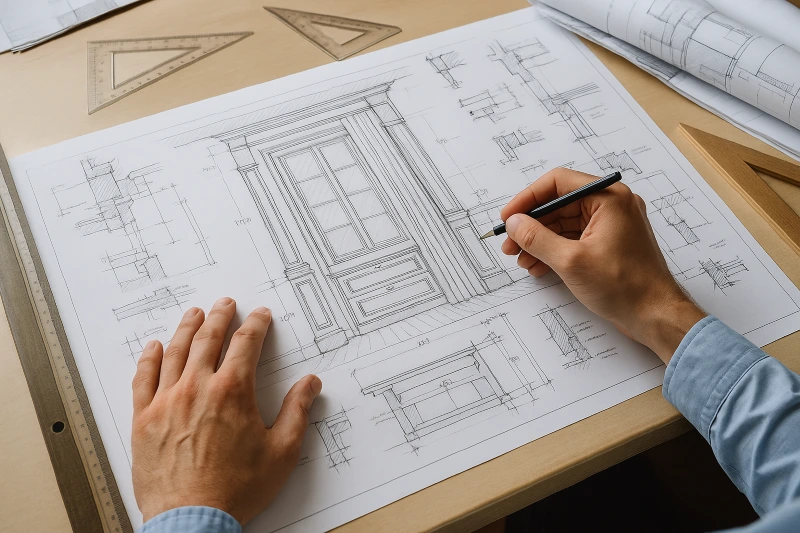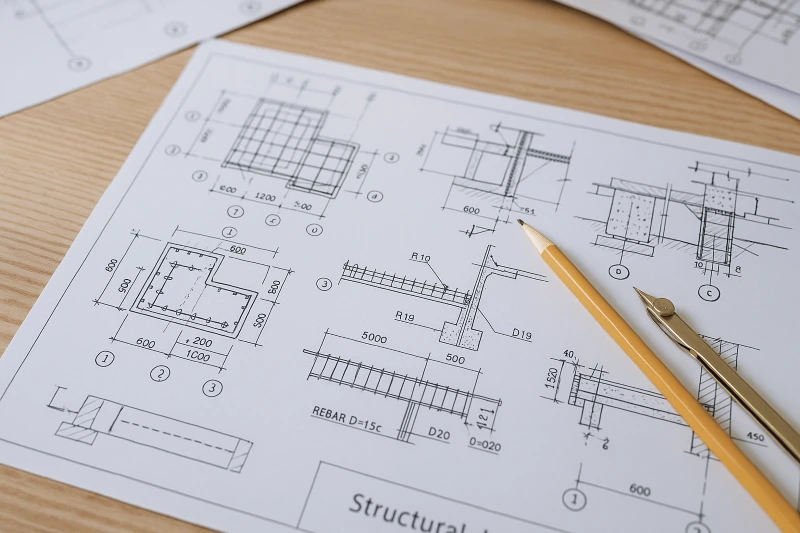With deep expertise in technical design, the UpTalent team helps companies understand how architectural and structural detailing work together to ensure every project is buildable, code-compliant, and true to the design vision.

Before any construction crew sets foot on-site, before materials are ordered, and long before walls start going up, there’s a different kind of work happening behind the scenes: the detailing.
We’re not talking about design sketches or concepts here — we mean the technical blueprints that tell the builders exactly how things should come together. And when it comes to construction, two types of detailing matter most: architectural and structural. They’re different, but both are essential, and knowing how they work can save you time, money, and a lot of headaches.
It might sound like a fine point — but trust us, it’s not.
Architectural and structural detailing are two sides of the same coin. One makes sure your building looks and feels the way it should. The other makes sure it doesn’t fall over. If you miss one, you could be dealing with code violations, confused builders, or costly delays down the line.
When both are done well — and done together — your project is smoother, safer, and more likely to stay on budget.
Think of architectural detailing as everything that gives a space its personality and usability. These are the drawings and specs that define finishes, fittings, trim, lighting, wall treatments — all the things that make a space feel polished, welcoming, and aligned with your vision.

You’ll see architectural details used to explain things like:
Architects use software like Revit or AutoCAD to bring these details to life, often working closely with interior designers and clients to make sure the final product reflects both the function and the feel you’re after.
While architectural detailing is all about form and finish — the parts of a building people interact with — structural detailing focuses on what makes the structure safe, sound, and durable. It’s less about visual impact and more about load paths, stress distribution, and materials that hold everything together.

The first step in structural detailing is designing the building’s foundation system. This includes plans that show where footings are located, how deep they go, and how they handle site conditions like soil type or groundwater. A well-detailed foundation ensures the building won’t shift, crack, or settle unevenly over time.
Structural detailers define the size, spacing, and materials of beams and columns — the core elements that support floors, walls, and roofs. These specifications aren’t just about strength; they also ensure that the loads are distributed efficiently across the entire structure, reducing the risk of failure and helping optimise material use.
Floor and roof systems must handle both static loads (like walls and furniture) and dynamic forces (like wind or seismic activity). Structural detailing includes layouts for framing, joists, and trusses, showing how each component fits and functions. These details are essential for contractors, who rely on precise measurements to ensure seamless assembly on-site.
This is where things get especially precise. Engineers specify how steel reinforcements are placed within concrete, how connections between materials are made, and how forces are transferred across joints. These small but critical details prevent cracks, warping, and failures under load. They also help meet strict building codes and pass inspections with confidence.
Here’s the heart of it:
On paper, they might live in the same drawing set. But they’re created by different specialists, reviewed by different departments, and serve different goals. Still, they need to work in sync — otherwise, the design might look beautiful but can’t be built as drawn, or the structure might work but kill the aesthetic.
Construction detailing is where everything comes together.
This kind of detailing bridges the gap between design and build — it’s how your drawings become instructions. These details guide contractors and tradespeople on how to install, connect, and align all parts of the structure and finishes.
This includes things like:
When done right, construction detailing eliminates guesswork and helps keep the worksite running smoothly.

Understanding when to involve architectural vs. structural detailers can save time, money, and headaches. The right expert at the right stage can make all the difference.
If your project is focused on aesthetics, atmosphere, and how people experience the space — think retail shops, boutique hotels, restaurants, or showrooms — then an architectural detailer is essential. They’ll translate design concepts into practical drawings that define finishes, materials, lighting layouts, millwork, and how everything ties together visually.
When the project involves anything that holds up the building — like foundation upgrades, framing changes, roof structures, or seismic reinforcements — you need a structural detailer or engineer. Their drawings ensure everything complies with safety codes, supports the right loads, and stands the test of time.
Planning a new building or doing a major rebuild? You’ll need both types of detailers — working side by side. The architectural team shapes the form and function, while the structural team ensures stability and safety. A strong collaboration between the two prevents gaps, clashes, and costly revisions later.
With Building Information Modelling (BIM), coordination is everything. Architectural and structural models must align perfectly to avoid conflicts. Many on-site issues arise because the two disciplines weren’t working from the same page. Ensuring your detailers are BIM-savvy and communicating well is key to avoiding construction delays.
Many architectural projects today rely on remote collaboration between architects, structural engineers, and detailers to ensure smooth project execution and design alignment. A detailed guide to working with online architects explores how remote cooperation is reshaping modern architectural workflows.
Here’s the takeaway: You need both kinds of detail to build something solid, smart, and stunning. Neither one is optional if you’re serious about doing things right.
If you’re hiring an architect, ask if structural detailing is included — it often isn’t. And if you’re working with a structural engineer, make sure their work aligns with your design goals. Better yet, make sure these pros are collaborating from the start.
When architectural and structural detailing are both done well — and done together — your project runs smoother, your team is happier, and your final result is something you can be proud of.
About the Author
With deep expertise in technical design, the UpTalent team helps companies understand how architectural and structural detailing work together to ensure every project is buildable, code-compliant, and true to the design vision.
Expertise:
Explore these related articles to dive deeper into the topic and discover more insights.

Customer Support Outsourcing: A Smart Solution for Small Businesses

The Role of a Partnership Manager in Building Strong Business Relationships

Data Entry vs Data Analyst: Which One Drives Better Business Insights?